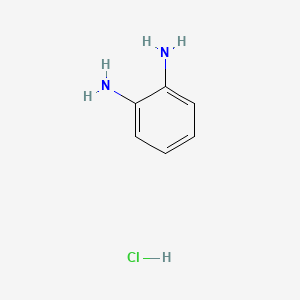
Benzene-o-diamine monohydrochloride
Vue d'ensemble
Description
Benzene-o-diamine monohydrochloride is a useful research compound. Its molecular formula is C6H9ClN2 and its molecular weight is 144.60 g/mol. The purity is usually 95%.
BenchChem offers high-quality this compound suitable for many research applications. Different packaging options are available to accommodate customers' requirements. Please inquire for more information about this compound including the price, delivery time, and more detailed information at [email protected].
Applications De Recherche Scientifique
Common Synthetic Routes
- Hydrochlorination of o-Phenylenediamine : This method involves treating o-phenylenediamine with hydrochloric acid to yield the monohydrochloride salt.
- Condensation Reactions : Benzene-o-diamine can react with various aldehydes and ketones to form valuable organic compounds such as benzimidazoles, which are important in medicinal chemistry.
Organic Synthesis
Benzene-o-diamine monohydrochloride serves as a versatile building block in organic synthesis. It participates in various condensation reactions leading to the formation of complex molecules.
- Benzimidazole Derivatives : It condenses with carboxylic acids to produce benzimidazole derivatives, which have applications in drug development and agrochemicals .
| Reaction Type | Product | Application |
|---|---|---|
| Condensation with carboxylic acids | Benzimidazoles | Pharmaceuticals |
| Reaction with aldehydes | 2-substituted benzimidazoles | Anticancer agents |
Pharmaceutical Applications
This compound is crucial in the pharmaceutical industry for synthesizing various drugs. Its derivatives exhibit a range of biological activities including:
- Anticancer Properties : Compounds derived from benzene-o-diamine have shown potential in inhibiting cancer cell proliferation .
- Antimicrobial Activity : Certain derivatives demonstrate significant antimicrobial effects against bacteria and fungi, making them candidates for developing new antibiotics.
Dye Manufacturing
The compound is also utilized in the dye industry due to its ability to form colored complexes with metals. It is particularly effective in producing azo dyes, which are widely used in textiles.
Case Study 1: Anticancer Activity
A study evaluated the anticancer properties of benzene-o-diamine derivatives against various cancer cell lines. The results indicated that specific derivatives inhibited cell growth significantly:
- Cell Lines Tested : A549 (lung adenocarcinoma), C6 (rat glioma).
- Inhibition Rates : Some derivatives achieved over 70% inhibition at specific concentrations.
Case Study 2: Antimicrobial Efficacy
Research focused on the incorporation of benzene-o-diamine derivatives into polymer matrices for dental applications showed promising results:
- Microbial Strains Tested : Candida albicans.
- Concentration Levels : Formulations containing 3% and 5% of the compound led to a reduction of fungal colonies by up to 3 log units compared to control groups.
Propriétés
Numéro CAS |
39145-59-0 |
|---|---|
Formule moléculaire |
C6H9ClN2 |
Poids moléculaire |
144.60 g/mol |
Nom IUPAC |
benzene-1,2-diamine;hydrochloride |
InChI |
InChI=1S/C6H8N2.ClH/c7-5-3-1-2-4-6(5)8;/h1-4H,7-8H2;1H |
Clé InChI |
GNNALEGJVYVIIH-UHFFFAOYSA-N |
SMILES canonique |
C1=CC=C(C(=C1)N)N.Cl |
Origine du produit |
United States |
Synthesis routes and methods
Procedure details












Avertissement et informations sur les produits de recherche in vitro
Veuillez noter que tous les articles et informations sur les produits présentés sur BenchChem sont destinés uniquement à des fins informatives. Les produits disponibles à l'achat sur BenchChem sont spécifiquement conçus pour des études in vitro, qui sont réalisées en dehors des organismes vivants. Les études in vitro, dérivées du terme latin "in verre", impliquent des expériences réalisées dans des environnements de laboratoire contrôlés à l'aide de cellules ou de tissus. Il est important de noter que ces produits ne sont pas classés comme médicaments et n'ont pas reçu l'approbation de la FDA pour la prévention, le traitement ou la guérison de toute condition médicale, affection ou maladie. Nous devons souligner que toute forme d'introduction corporelle de ces produits chez les humains ou les animaux est strictement interdite par la loi. Il est essentiel de respecter ces directives pour assurer la conformité aux normes légales et éthiques en matière de recherche et d'expérimentation.














